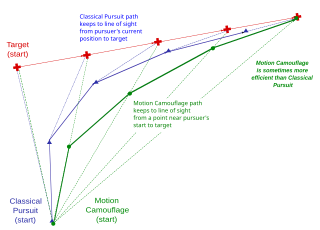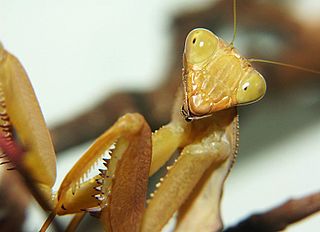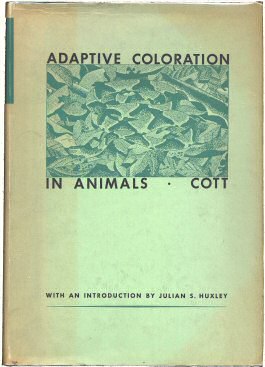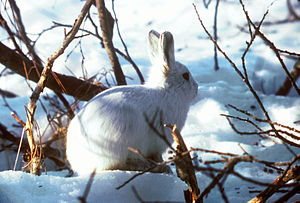
Camouflage is the use of any combination of materials, coloration, or illumination for concealment, either by making animals or objects hard to see, or by disguising them as something else. Examples include the leopard's spotted coat, the battledress of a modern soldier, and the leaf-mimic katydid's wings. A third approach, motion dazzle, confuses the observer with a conspicuous pattern, making the object visible but momentarily harder to locate. The majority of camouflage methods aim for crypsis, often through a general resemblance to the background, high contrast disruptive coloration, eliminating shadow, and countershading. In the open ocean, where there is no background, the principal methods of camouflage are transparencying, silveringing, and countershading, while the ability to produce light is among other things used for counter-illumination on the undersides of cephalopods such as squid. Some animals, such as chameleons and octopuses, are capable of actively changing their skin pattern and colors, whether for camouflage or for signalling. It is possible that some plants use camouflage to evade being eaten by herbivores.

Nocturnality is a behavior in some non-human animals characterized by being active during the night and sleeping during the day. The common adjective is "nocturnal", versus diurnal meaning the opposite.

Anti-predator adaptations are mechanisms developed through evolution that assist prey organisms in their constant struggle against predators. Throughout the animal kingdom, adaptations have evolved for every stage of this struggle, namely by avoiding detection, warding off attack, fighting back, or escaping when caught.

Deilephila elpenor, the elephant hawk moth or large elephant hawk moth, is a moth in the family Sphingidae. Its common name is derived from the caterpillar's resemblance to an elephant's trunk. It is most common in central Europe and is distributed throughout the Palearctic region. It has also been introduced in British Columbia, Canada. Its distinct olive and pink colouring makes it one of the most recognisable moths in its range. However, it is quite easy to confuse the elephant hawk moth with the small elephant hawk moth, a closely related species that also shares the characteristic colours.

Aposematism is the advertising by an animal, whether terrestrial or marine, to potential predators that it is not worth attacking or eating. This unprofitability may consist of any defenses which make the prey difficult to kill and eat, such as toxicity, venom, foul taste or smell, sharp spines, or aggressive nature. These advertising signals may take the form of conspicuous coloration, sounds, odours, or other perceivable characteristics. Aposematic signals are beneficial for both predator and prey, since both avoid potential harm.

In ecology, crypsis is the ability of an animal or a plant to avoid observation or detection by other animals. It may be a predation strategy or an antipredator adaptation. Methods include camouflage, nocturnality, subterranean lifestyle and mimicry. Crypsis can involve visual, olfactory or auditory concealment. When it is visual, the term cryptic coloration, effectively a synonym for animal camouflage, is sometimes used, but many different methods of camouflage are employed in nature.
A kairomone is a semiochemical released by an organism that mediates interspecific interactions in a way that benefits a different species at the expense of the emitter. Derived from the Greek καιρός, meaning "opportune moment", it serves as a form of "eavesdropping", enabling the receiver to gain an advantage, such as locating food or evading predators, even if it poses a risk to the emitter. Unlike allomones, which benefit the producer at the receiver's cost, or synomones, which are mutually beneficial, kairomones favor only the recipient. Primarily studied in entomology, kairomones can play key roles in predator-prey dynamics, mate attraction, and even applications in pest control.

Motion camouflage is camouflage which provides a degree of concealment for a moving object, given that motion makes objects easy to detect however well their coloration matches their background or breaks up their outlines.

Mobbing in animals is an anti-predator adaptation in which individuals of prey species cooperatively attack or harass a predator, usually to protect their offspring. A simple definition of mobbing is an assemblage of individuals around a potentially dangerous predator. This is most frequently seen in birds, though it is also known to occur in many other animals such as the meerkat and some bovines. While mobbing has evolved independently in many species, it only tends to be present in those whose young are frequently preyed upon. This behavior may complement cryptic adaptations in the offspring themselves, such as camouflage and hiding. Mobbing calls may be used to summon nearby individuals to cooperate in the attack.

Matutinal, matinal, and matutine are terms used in the life sciences to indicate something of, relating to, or occurring in the early morning. The term may describe the morning activities of crepuscular animals that are significantly active during the predawn or early hours and which may or may not then be active again at dusk, in which case the animal is also said to be vespertinal/vespertine. During the morning twilight period and shortly thereafter, these animals partake in important tasks, such as scanning for mates, mating, and foraging.

The ability to sense infrared thermal radiation evolved independently in three different groups of snakes, consisting of the families of Boidae (boas), Pythonidae (pythons), and the subfamily Crotalinae. What is commonly called a pit organ allows these animals to essentially "see" radiant heat at wavelengths between 5 and 30 μm. The more advanced infrared sense of pit vipers allows these animals to strike prey accurately even in the absence of light, and detect warm objects from several meters away. It was previously thought that the organs evolved primarily as prey detectors, but recent evidence suggests that it may also be used in thermoregulation and predator detection, making it a more general-purpose sensory organ than was supposed.

Vision is the most important sense for birds, since good eyesight is essential for safe flight. Birds have a number of adaptations which give visual acuity superior to that of other vertebrate groups; a pigeon has been described as "two eyes with wings". Birds are theropods, and the avian eye resembles that of other sauropsids, with ciliary muscles that can change the shape of the lens rapidly and to a greater extent than in the mammals. Birds have the largest eyes relative to their size in the animal kingdom, and movement is consequently limited within the eye's bony socket. In addition to the two eyelids usually found in vertebrates, bird's eyes are protected by a third transparent movable membrane. The eye's internal anatomy is similar to that of other vertebrates, but has a structure, the pecten oculi, unique to birds.

Sphodromantis lineola, common name African mantis or African praying mantis, is a species of praying mantis from Africa sometimes raised in captivity. S. lineola is often colored green, however they can also be colored different types of brown. The brown colored individuals have also been observed with purple colored eyes. It may be distinguished from S. baccettii by the absence of blue-black spots on its forearms.

Empusa pennata, or the conehead mantis, is a species of praying mantis in genus Empusa native to the Mediterranean Region. It can be found in Portugal, Spain, southern France, Italy and on the mediterranean coasts of Morocco, Algeria, Tunisia, Libya, Turkey and Egypt. Because of its cryptic nature, or also possibly because of its fragmented, low-density populations, it is rarely encountered in the wild.

Structures built by non-human animals, often called animal architecture, are common in many species. Examples of animal structures include termite mounds, ant hills, wasp and beehives, burrow complexes, beaver dams, elaborate nests of birds, and webs of spiders.

Vision is an important sensory system for most species of fish. Fish eyes are similar to the eyes of terrestrial vertebrates like birds and mammals, but have a more spherical lens. Birds and mammals normally adjust focus by changing the shape of their lens, but fish normally adjust focus by moving the lens closer to or further from the retina. Fish retinas generally have both rod cells and cone cells, and most species have colour vision. Some fish can see ultraviolet and some are sensitive to polarised light.

Adaptive Coloration in Animals is a 500-page textbook about camouflage, warning coloration and mimicry by the Cambridge zoologist Hugh Cott, first published during the Second World War in 1940; the book sold widely and made him famous.
Most fish possess highly developed sense organs. Nearly all daylight fish have colour vision that is at least as good as a human's. Many fish also have chemoreceptors that are responsible for extraordinary senses of taste and smell. Although they have ears, many fish may not hear very well. Most fish have sensitive receptors that form the lateral line system, which detects gentle currents and vibrations, and senses the motion of nearby fish and prey. Sharks can sense frequencies in the range of 25 to 50 Hz through their lateral line.
Lizards are among the most diverse groups of reptiles, with more than 5,600 species. With such diversity in physical and behavioral traits, lizards have evolved many ways to communicate. Communication may be physical, chemical, tactile, or vocal, and varies according to habitat, sexual selection practices, and predator avoidance methods. Each type of communication uses different sensory systems, including visual, olfactory, and auditory.

Communication occurs when an animal produces a signal and uses it to influences the behaviour of another animal. A signal can be any behavioural, structural or physiological trait that has evolved specifically to carry information about the sender and/or the external environment and to stimulate the sensory system of the receiver to change their behaviour. A signal is different from a cue in that cues are informational traits that have not been selected for communication purposes. For example, if an alerted bird gives a warning call to a predator and causes the predator to give up the hunt, the bird is using the sound as a signal to communicate its awareness to the predator. On the other hand, if a rat forages in the leaves and makes a sound that attracts a predator, the sound itself is a cue and the interaction is not considered a communication attempt.



















